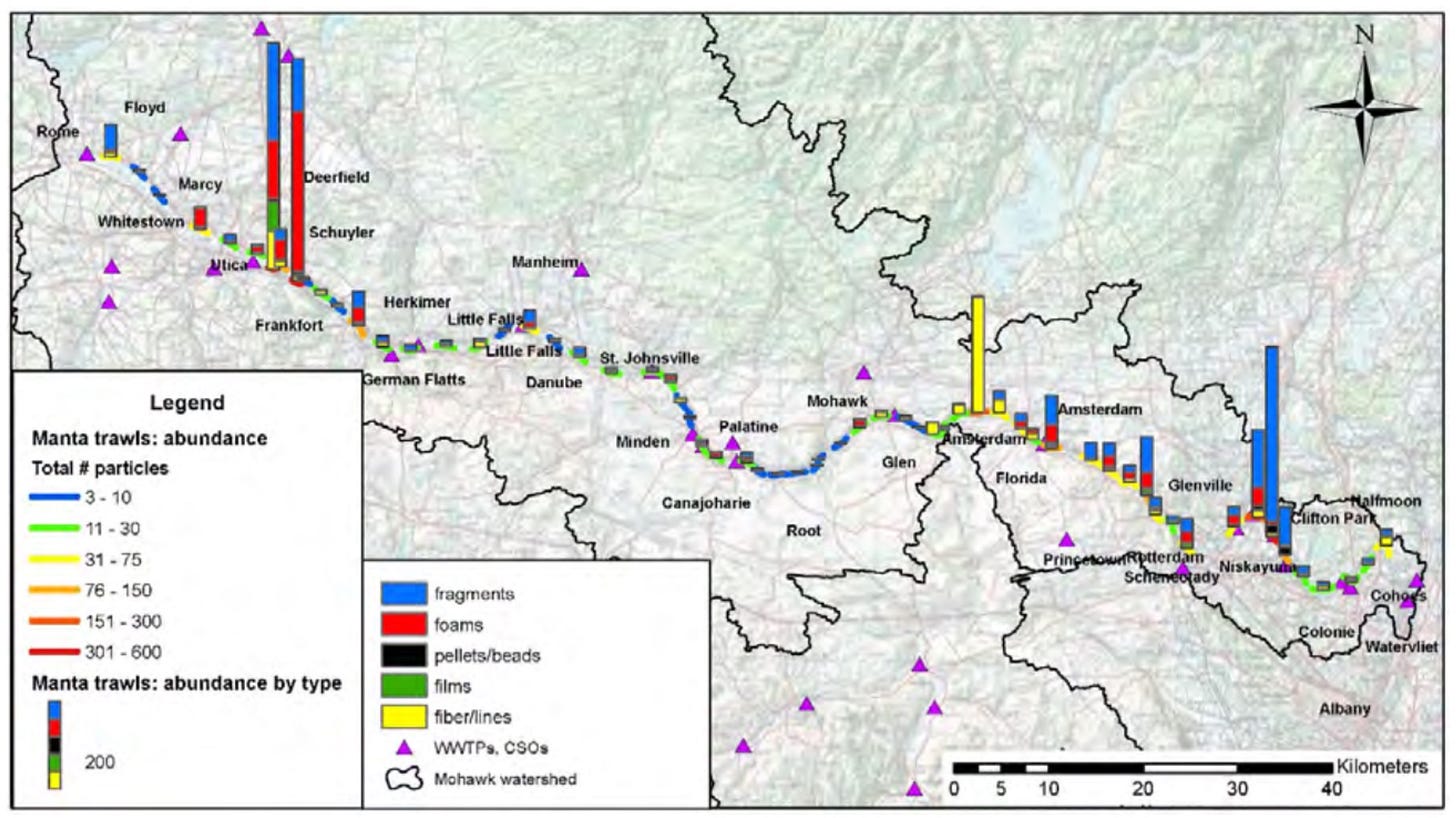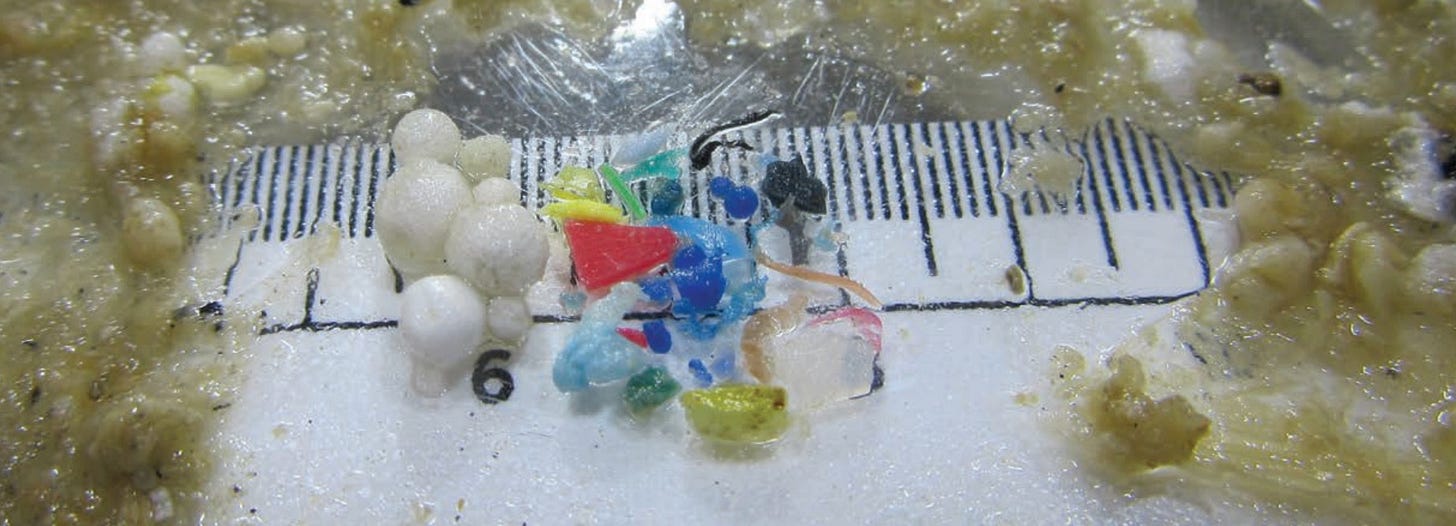Microplastics in the Mohawk
A looming problem that affects water quality
Microplastics are everywhere in the Mohawk and Hudson rivers. Recent work has shown that a large fraction of the microplastic waste that ends up in our rivers is from plastic litter from urban areas and stormwater/wastewater conduits.
Microplastic debris comes in all shapes, sizes, and compositions. Most of the material in the water column is lighter than water, and thus it floats: most particles are made of polystyrene, polypropylene, and polyethylene.
Recent detailed and exhaustive work in the Mohawk watershed provide us with an incredible detailed picture of the microplastic problem in the watershed. Given the depth and breadth of this new research, it is possible that the Mohawk is one the best-studied waterways in the Northeast (see this from 2016, this from 2017, this from 2018, and this one from 2019).

Microplastics are typically sampled with a manta trawl that has a fine mesh net that traps particles as the trawl is pulled through the water. This photo shows part of the sampling program on the Mohawk River in 2018 (photo: J.A. Smith, Union College).
This work shows that there are two principle pathways of microplastics into the River. One is from surface runoff, and this includes tributaries, streams, and drainage from cities and towns where plastic is common as discarded trash. A second is from wastewater treatment plants (WWTPs) that are not equipped to filter out small plastic particles, and a third is from stormwater outfalls and combined sewer systems (CSSs), both of which provide a direct means for plastic waste to enter waterways during heavy precipitation events.
Intensive sampling along the entire main stem of the Mohawk by Dr. Jacquie Smith and colleagues at Union College provides the first detailed analysis of microplastic pollution in the River. The highest abundance of plastics is near urban settings. In a recent summary, Smith and colleagues wrote:
Variations in proportions of plastic types in surface water likely reflect the influence of local inputs, such as surface runoff, combined sewer overflows, and WWTP effluent, which deliver pulses or streams of particles with characteristic features (e.g., Styrofoam particles in Utica, blue microbeads in Schenectady). In some cases, high abundance of microplastic particles corresponds closely to proximity to WWTP outflow, but not in all cases.

Map of microplastic distribution in the River from Smith et al., 2018 showing the abundance of particles collected from 63 manta trawl samples between Rome and Cohoes in the Mohawk River and Erie Canal (June to October 2016). The highest abundances were found in samples from Utica/Frankfort and Schenectady/Niskayuna. Vertical bar graphs show samples color coded by type (fragment, foam, pellet/bead, film, fiber/line).
Subsequent work by Dr. Smith and her team focussed on 21 creeks and streams of various sizes that flow into the Mohawk. A central question of this part of the research is the contribution of small creeks and streams to the microplastic load in the River. One of the studied creeks is the Hans Groot Kill (HGK), a highly impaired urban stream in Schenectady that partly serves as a stormwater discharge channel. For all the small creeks and streams, they conclude:
High abundance and/or concentration of particles appears to correlate with storm -drain inflow, sewage leakage, and runoff that transports plastic waste to the stream channel. HGK is exposed at the surface for only -1.2 km; upstream and downstream reaches are carried in culverts. Samples were collected at the downstream end of the exposed section. Storm-drain and other pipe outfalls punctuate the banks of the open-air HGK. High Enterococci and E. coli levels in HGK suggest that sewage is reaching the stream. Similarly, the low-flow stream with the highest particle abundance and concentration has a documented history of sewage contamination by leaking pipes.
One interesting conclusion from this work is that the variation in microplastic abundance along the length of the main stem of the Mohawk is not uniform. This observation would seem to suggest that particles may be sequestered in wetland areas, and also diluted to some extent at the pooled eastern end of the river (between lock E8 and Cohoes Falls). These conclusions may mean that during floods much of this plastic material is mobilized and flushed out the river into the Hudson.

Microplastic particles from the Mohawk River in Utica, recently highlighted in this overview paper that summarizes this research effort on the Mohawk (Photo JA Smith, Union College).
Why worry about microplastics? Aren’t they inert and harmless? We do, after all use these plastics to wrap and store food. Aside from the obvious issues related to degradation of the aquatic environment, part of the answer may be rooted in how microplastics breakdown into even smaller particles: nanoplastics.
Nanoplastics
Macroplastics make microplastics and microplastics make nanoplastics. Microplastics are <5 mm (or 5000 microns). A typical human hair is about 100 microns, near the lower size range, so these are indeed small particles – certainly small enough to be ingested a wide variety of organisms in the aquatic food chain.
Nanoplastics are even smaller: < 1 um or 1 micron (< 1000 nanometers). It is thought that most nanoplastics are formed by the degradation of larger pieces of plastic, and these are referred to as secondary nanoplastics.
For some time a critical question has been to understand how quickly different plastics break down in the natural environment. Abrasion (mechanical) and photodegration (chemical) are common mechanisms that cause size-reduction in plastic particles. Thus when microplastics breakdown into smaller nano-fragments, we likely have a whole new set of problems.
It is now appreciated that nanoplastics are ubiquitous in the aquatic environment, but they have received little attention because they are analytically challenging. There has been a concern that they can penetrate into living tissue and vital organs of aquatic organisms - and non-aquatic organisms like you and me.
In research conducted at Woods Hole Oceanographic Institution (WHOI), Jordan Pitt did experiments with tagged nanoplastics, and her research showed that during fish reproduction, nanoplastics easily penetrated cellular membranes of embryos. The nanoparticles were able to migrate into the liver, pancreas, heart, and brain. The study showed that some of the young fish with nanoplastics in internal organs had physical impairment. Toxicologist Mark Hahn, also on the research team at Woods Hole Oceanographic Institution (WHOI), noted:
“Microplastics tend to stay in the intestines of organisms and then get flushed out, but nanoplastics may be small enough to get into the circulation and cross the tight protective barrier that blood vessels form around the brain. If that’s happening, we’d then need to understand the effect it may have on how the brain functions.”
This is important, and profound: nanoplastics can cross the blood-brain barrier. He also noted:
“We’re ingesting nanoplastics at unknown concentrations, so it’s important that we determine what the plastics do after we consume them.”
So this recent work shows that microplastics are pervasive in the Mohawk, and they are most abundant in urban centers. Undoubtedly nanoplastics are also ubiquitous in the river, but we really have no idea what affect they may have on aquatic life.
This and other Notes from a Watershed are available at: https://mohawk.substack.com/